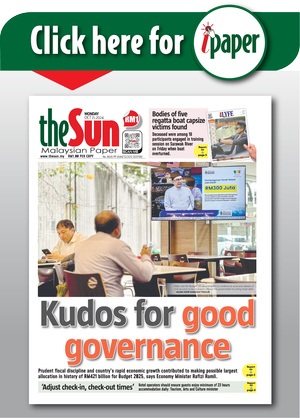THE Airbus A380, the world’s biggest commercial aircraft, went into service on Oct 2007 with Singapore Airlines.
To date Airbus Industrie, the European manufacturer, has received 251 firm orders for the aircraft and delivered 242, with Emirates being its biggest customer with 115 of the wide-bodied aircraft.
Hot on the heels of Singapore Airlines, Qantas and Thai International Airways, Malaysia – through Malaysia Airlines Berhad, a Khazanah Nasional company – ordered six of these giants, targeting its key trunk routes to Europe and the Asia-Pacific Region.
Has the purchase of the A380 proven to be a success or are they destined for long-term parking at Pinal Airpark Marana, Arizona or Alice Springs in Australia? Or was it a wrong buy?
Sitting there precariously are the elegant six Malaysia Airlines Airbus A380s, a monster of a flying machine, in one corner of KL International Airport (KLIA).
It’s such a pitiful sight, victims of the Covid-19. So are the many other aircraft of two Malaysia’s domestic/regional carriers, Air Asia and Malindo as well AirAsia’s international brother, AirAsia X.
The situation is the same at all other international airports throughout the world, with aircraft parked all over the place, including the taxiways.
Aircraft are supposed to be up in the air, coming in only to offload or pick up passengers.
But with the pandemic and borders closed most of them, except for freighters, are grounded.
For long-term parking, many are sent to the Mojave Desert, Pinal Airpark Marana, Arizona or Alice Springs in Australia.
The six Malaysia Airlines A380s, even before the pandemic, had not been flying much. Only to London, Hong Kong, Sydney and ad hoc to Seoul, South Korea.
Otherwise they were mainly used for Haj charters, which covers only about three months in a year and the Umrah flights to Jeddah and Medina.
Their utilisation, by any standards is low and not up to expectation.
The aircraft is a colossal monster – a double-decker, the biggest commercial aircraft ever built.
At its maximum it weighs more than 600 tons, more than one third of it is taken up by fuel.
For a flight to London from KLIA, the aircraft can consume up to 200 tons of gasoline.
To enable the aircraft to operate, due to its heavy weight and size, taxiways have to be strengthened and widened.
Likewise, the boarding bay had to be modified to enable simultaneous boarding/disembarkation for both decks.
Depending on the configuration, it can accommodate more than 500 passengers on its twin deck.
In the case of Malaysia Airlines, in a three-class configuration – eight first class, 66 business and 412 in the economy class – the aircraft has a total of 486 seats.
Some airlines have less seats, with space being spared for a lounge for first class passengers. They even have a facility to shower on board.
The challenge really is to fill up the aircraft for economic viability. So it was often asked: “Was the aircraft a wrong buy?”
Without doubt, anybody can be wise with the benefit of hindsight. Let me however, address the issue objectively, hopefully with no bias.
Firstly, let’s be clear the aircraft was purchased for Malaysia Airlines Berhad by Khazanah, upon recommendation by the airline.
Having said that, buying new aircraft is a major decision. It involves billions of dollars of investment.
So any decision to be made for such purchases would only be done after a thorough feasibility study by a project team set up for such purposes.
One thing we have to know, aviation is one of the industries that undergoes constant and rapid changes.
In the last three decades, the technology in aircraft and engine designs, the air regulations pertaining to two-engine operations among other things, have changed tremendously.
It is a fact, at the turn of the 20th century, there was a boom in air travel, especially in the Asia Pacific region. Airlines had their aircraft generally filled up.
The B747-400 aircraft, dubbed the queen of the sky, was the most popular aircraft for Trans-Continental routes, from Australia, across Southeast Asia and onwards to Europe.
Malaysia Airlines had a fairly good share of air travellers, the economy and business sections were generally full all the time.
Only the First Class section experienced poor load, simply because the fare was too expensive. Only royalties and ministers could afford it. Even CEOs of big companies travelled with business class.
Following market demand, the industry saw a need to have an aircraft with a bigger capacity.
That’s where Airbus Industrie came up with the A380.
To be part of the league and not be left behind with other competitors in the region, Singapore Airlines ordered 19, and Thai International and Qantas both ordered six. Malaysia Airlines, got caught in the web.
A major consideration for new aircraft purchases, is indeed commercial and market demand.
Malaysia Airlines had to consider joining the bandwagon lest it be pushed out of competition and following a feasibility study committed to ordering six of them.
Like all other airlines, there were many other factors that had to be considered before making the decision. One of the factors was aircraft replacement.
Malaysia Airlines’ workhorse for international routes was the Boeing 747-400 (B747-400), which were then about 18 years old and would have to be phased out in years to come anyway.
To Airbus Industrie, typical of all aircraft manufacturers, the selling point was to have an aircraft with great performance and more fuel efficient engines.
The airline, through a project team consisting of pilots from the technical and development department, together with engineers from the technical services department, would conduct a detailed study on the performance figures provided by the aircraft manufacturer and present their recommendations to the board.
They came up with the decision to order six A380s plus a simulator from a Canadian company to train the crew.
A simulator is necessary for training and biannual checks. Otherwise other airline facilities would have to be used, incurring more costs in terms of simulator usage, crew travel and allowances, and hotel accommodation.
The simulator at the training complex in Subang is however, now underutilised.
While we made the decision to go for it, mega carriers in the Middle East had their plans.
They, too, ordered the giant aircraft, with Etihad and Qatar ordering 10 each and, the biggest of all, Emirates, an unbelievable number of 118.
Together they eventually conquered the Australian and Southeast Asian market, leaving Malaysia Airlines to pick up the crumbs.
That’s the airline business for you – highly volatile and very competitive. So, was it wrong to buy the six then?
Personally l don’t think it was wrong to go for it as there was market demand. Malaysia Airlines had to be competitive, and the B747-400 aircraft was aging and had to be phased out. So replacement aircraft had to be ordered in advance.
The A380 itself is superb and high tech, well liked by passengers for its roomy cabin, enchanting cabin lighting and superb in-flight entertainment system.
Pilots also liked the aircraft as flying it was just like playing a computer game.
For in-flight rest, crew bunks were very comfortable, complete with the “bantal pelok”, that some of them found it difficult to wake up to take over flight duties.
In terms of fuel efficiency, it is not much better than the aircraft it replaced, the B747-400. But the A380, has its drawbacks.
Besides being huge coupled with the challenges of filling up seats, the aircraft is not as versatile as the B747-400.
Even if the seats can be filled up the yield is low, and more often than not it’s one way traffic.
Furthermore, it simply cannot operate at airports not prepared for it. In Malaysia, KLIA is the only airport that can accommodate the aircraft.
Whereas the B747-400 can operate at all major airports in the country – Penang, Langkawi, Kuala Trengganu and Kota Kinabalu with no restrictions.
For Haj Charters, some of the B747 flights operated directly from Penang, Kuala Trengganu and Kota Kinabalu, hence rendering feeder services unnecessary when bringing pilgrims to KLIA.
So, where do we go from here after being caught in an unexpected and undesirable situation?
Malaysia Airlines has decided to turn the fleet into charter operations under a subsidiary, Amal, specialising in Haj and Umrah Charters.
Haj charters are just a once a year affair lasting for a period at most for two to three months only, and the traffic is one way. Full on the way up, empty on the way back and vice versa.
Therefore, the total load factor can be taken as just 50%. So how can we make money?
The Umrah charters are ad hoc, and the market is unpredictable and can be seasonal.
Overall, the operating cost far outweighs the revenue that it can generate. Indeed, the future of the aircraft looks bleek.
Given the dynamics of the aviation industry, both aircraft manufacturers, Airbus Industrie and Boeing have come up with another long range, medium-sized twin-engine aircraft – the Airbus A350 and the Boeing B777X respectively – to take over the airways. They are, again, reputed to be more fuel efficient – a key selling point.
Why operate routes with a four-engine aircraft when it can be done by one with two engines?
Where do we go from here? I would suggest cutting losses, have the aircraft on long-term parking while making continued attempts to sell them.
Perhaps we can approach Qatar Airways to buy them at a discounted price as they could make good use of them.
Qatar would be a better bet due to our close ties with them, and our top officials can probably negotiate a deal for the aircraft.
Singapore Airlines is reportedly planning to take seven of the 19 it has out of the system.
With the Covid-19 pandemic, the aviation industry is badly hit. The more aircraft airlines have, the more losses they will incur.
Into the new year, the future is still uncertain. And that includes the future of Malaysia Airlines’s six Airbus A380.
Capt Mohd Kamil Abu Bakar is a former director of flight operations with Malaysia Airlines. Comments: letters@thesundaily.com








